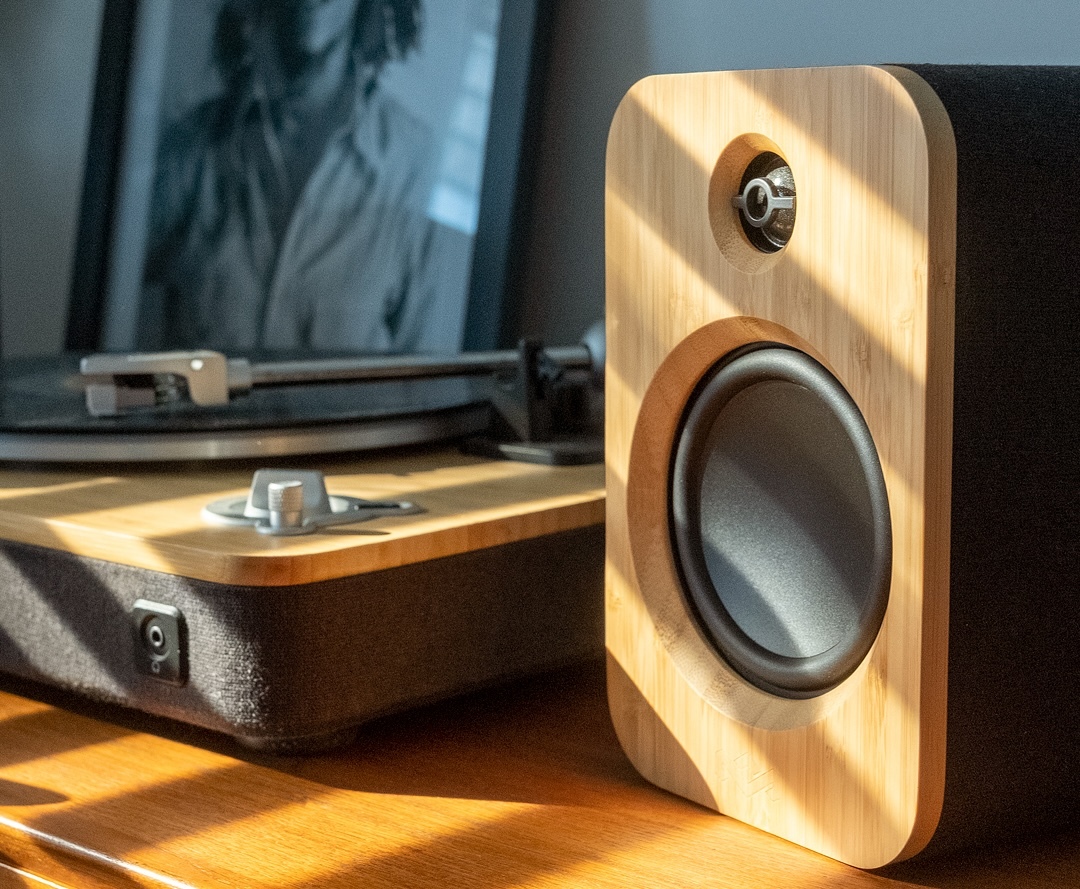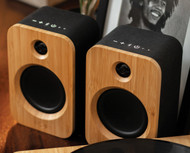What Are Bookshelf Speakers? Everything to Know
Posted by House of Marley on May 21st 2024
Imagine a world where you could have top-notch sound in your home without an enormous hi-fi speaker setup. Picture yourself in that world, comfortably listening to your favorite songs the way the artist intended.
As it turns out, that world already exists—thanks to bookshelf speakers.
The bookshelf speaker is nothing short of a modern engineering miracle. These sonic powerhouses pack exceptional sound quality and volume into a neat little package, allowing anyone to enjoy world-class listening in a smaller space.
If that sounds like the kind of listening experience you’re after, you’ve come to the right place. Join us as we dive deep into the very real world of bookshelf speakers.
Your Questions, Answered: What Are Bookshelf Speakers?
So, what are bookshelf speakers, exactly?
Simply put, bookshelf speakers are small or mid-sized speakers that can fit on your bookshelf, table, or other surface. They differ from the large, floor-standing “tower” speakers, which were the standard setup for home listeners until the bookshelf speaker was introduced.
Bookshelf speakers are the ultimate sonic solution for apartments, bedrooms, and other small spaces. They don’t fill the room. But their sound does. A bookshelf speaker is a perfect alternative to a floor speaker in that it delivers a similar listening experience.
To get an idea of the size and shape of bookshelf speakers, check out the Get Together Duo Bluetooth® Bookshelf Speakers from House of Marley and experience the benefits of bluetooth speakers today.
What is the Point of Bookshelf Speakers?
As you might have guessed, bookshelf speakers are the ideal size for your bookshelf. With that said, few people actually place their speakers on the bookshelf. Think about it: How often do you sit in front of your books and listen to music?
The term “bookshelf” refers mostly to the size of the speaker—in other words, you could put your speakers on the shelf. And if that kind of setup makes sense for the layout of your home, go for it.
However, the world is your oyster with bookshelf speakers. The point of them is that you can enjoy their high-quality sound almost anywhere. For example, you can set them up:
- At your desk at home
- On your TV stand
- With your gaming setup
- In your office at work
- On the dining room table
- Alongside your turntable
- On speaker stands
Ultimately, bookshelf speakers are designed to go anywhere but on the floor (although there’s nothing wrong with setting them up on the ground).
Wherever you put your bookshelf speaker, you can rest easy knowing your high-quality sound system isn’t taking up too much room.
The Benefits of Bookshelf Speakers
Wondering if bookshelf speakers are right for you? They probably are—because their qualities make them perfect for just about anyone.
We love bookshelf speakers because they’re:
- Compact – Most bookshelf speakers are no more than a foot tall, so they’re easy to fit into your life. Simply slot them in anywhere that makes sense, and enjoy quality audio all day, every day.
- Portable – Thanks to their low profile and lightweight design, these portable speakers are effortless to move from room to room whenever you feel like redecorating. For even more mobility, you can purchase a pair of wireless bookshelf speakers; the battery-powered units can go anywhere with you. With that said, the debate between wireless vs wired speakers often centers on convenience versus audio quality, a key consideration as you choose the right speakers for your home.
- Powerful – Despite their size, bookshelf speakers pack a punch. These tiny titans are endlessly versatile, allowing you to fill the room when you have company and enjoy quiet listening sessions at home—all with the same setup.
- Affordable – Thanks to being a compact speaker option, bookshelf speakers tend to be less pricey than their larger counterparts. You can expect to pay at least double for full-sized speakers.
- Stylish – Because bookshelf speakers are meant to blend in with your home decor, they’re typically designed with visual appeal in mind. You’ll find all kinds of different colors and finishes to suit your personal aesthetic.
Bookshelf Speaker Use Cases
Regardless of the size of your home or your listening preferences, you can probably find a situation where bookshelf speakers work for you. These are some of the most common use cases for these shelf-sized speakers.
Record Player or Turntable Setups
Bookshelf speakers are practically made for the at-home turntable setup. Turntables take up a decent amount of surface real estate, so bookshelf speakers are the ideal match. They’ll also faithfully reproduce the sound of your favorite records; most bookshelf speakers have a wide dynamic range.
And bookshelf speakers are a smart choice from a visual standpoint, too. Floor-standing speakers can dwarf a turntable, making your setup look mismatched and out of place. Bookshelf speakers, meanwhile, are a complementary size.
If you do decide to pair your turntable with bookshelf speakers, keep this piece of advice in mind: Try to place your speakers on a separate surface from your turntable. Otherwise, vibrations from the speakers can affect your playback quality.[1]
Home Theater Systems
Who says a home theater needs enormous tower speakers? Bookshelf speakers allow you to enjoy the full cinema experience, even if you live in a studio apartment.
To get started with a low-profile home theater setup, take your bookshelf speakers and place them an equal distance away from the screen. Your goal is to create a triangle between yourself and the two speakers. You can also connect multiple bookshelf speakers for that surround sound feeling.
Now you enjoy the movie theater experience anytime!
Home Studios
Bookshelf speakers can also be a worthwhile purchase for all the musicians and mix engineers out there.
Now, you may not want to use bookshelf speakers as your primary monitors for mixing, as the sound probably won’t be as “neutral” as you’re looking for. However, thanks to their compact size, bookshelf speakers make excellent reference speakers.
In other words, if you want to hear how your mix will sound to the average listener on their bookshelf speakers, having your own in the studio is a fantastic idea.
How to Position Bookshelf Speakers
Before you rush out and buy a new set of bookshelf speakers, you may want to think about where you’ll put them to optimize your listening experience. The beauty of bookshelf speakers is that they sound amazing everywhere, but if you want to make the most of your purchase, you’ll want to carefully consider the placement of your speakers.
Positioning your speakers for the best possible sound comes down to three variables:
- Spacing – Ideally, your bookshelf speakers should be at least four feet apart. If they’re too close, you’ll lose out on the full stereo effect.
- Height – Aim to position your speakers at the same height as your ears—after all, that’s where the sound needs to go. Thankfully, bookshelf speakers allow you to be creative with placement. You can put them on a shelf, table, stands, or any other surface that aligns the speaker cones with your ears.
- Distance from the wall – If you have the space, try to keep your bookshelf speakers two to three feet away from the back wall.[1] This placement will minimize reflections and give you a crystal-clear sound.
Position your bookshelf speakers well, and they’ll never let you down.
Comparing Bookshelf Speakers to Other Options
Although bookshelf speakers are the most versatile option around, they’re not your only choice. Different speakers may be better suited to different people, spaces, or use cases.
In the interest of completeness, let’s explore some of the other speaker types on the market and see how they compare.
Bookshelf Speakers vs. Powered Monitors
At first glance, powered monitors look exactly like bookshelf speakers. They’re roughly the same shape and size, and they’re designed to sit on your desk.
So, what’s the difference? Powered monitors are meant for music production in professional or at-home studios. Mix and mastering engineers use powered monitors to listen back to in-progress music and make adjustments that will translate to any system.
As such, powered monitors tend to be “flat.” They’re built to have minimal “color” so that engineers can accurately listen back to their music.
Bookshelf speakers, on the other hand, will all sound a little different. They’re designed to play finished songs—not unfinished ones—so they have differing amounts of bass, mids, treble.
There’s also the question of power: Powered monitors are always active, while bookshelf speakers may be passive (power required) or active speakers.
Bookshelf Speakers vs. Floor-Standing Speakers
The difference between bookshelf and floor-standing or tower speakers is more obvious. Tower-like floor-standing speakers are larger and taller, while bookshelf options are more compact.
In terms of sound, floor-standing speakers will have a richer, louder sound, thanks to the array of built-in tweeters and drivers. That said, tower speakers are also far more expensive than accessible bookshelf speakers.

Discover Bookshelf Speakers and More from House of Marley
Bookshelf speakers are the ultimate everyday listening tool. They offer the perfect compromise between sound quality and size, and they can fill out any room in your house. And when you opt for Bluetooth bookshelf speakers, they can join you outside of the house, too.
Whether you’re looking for a single bookshelf speaker or a pair, House of Marley has you covered. Our sustainable speakers are crafted with the music lover in mind.
Shop all speakers and our other sound offerings, such as headphones and record players to find your sonic match today.
Sources:
Vinyl Chapters. Turntable and Speaker Placement – A Guide To Setting Up. https://www.vinylchapters.com/turntable-and-speaker-placement-a-guide-to-setting-up/
Lifewire. How to Place Stereo Speakers for the Best Performance. https://www.lifewire.com/placing-speakers-correctly-3134857













